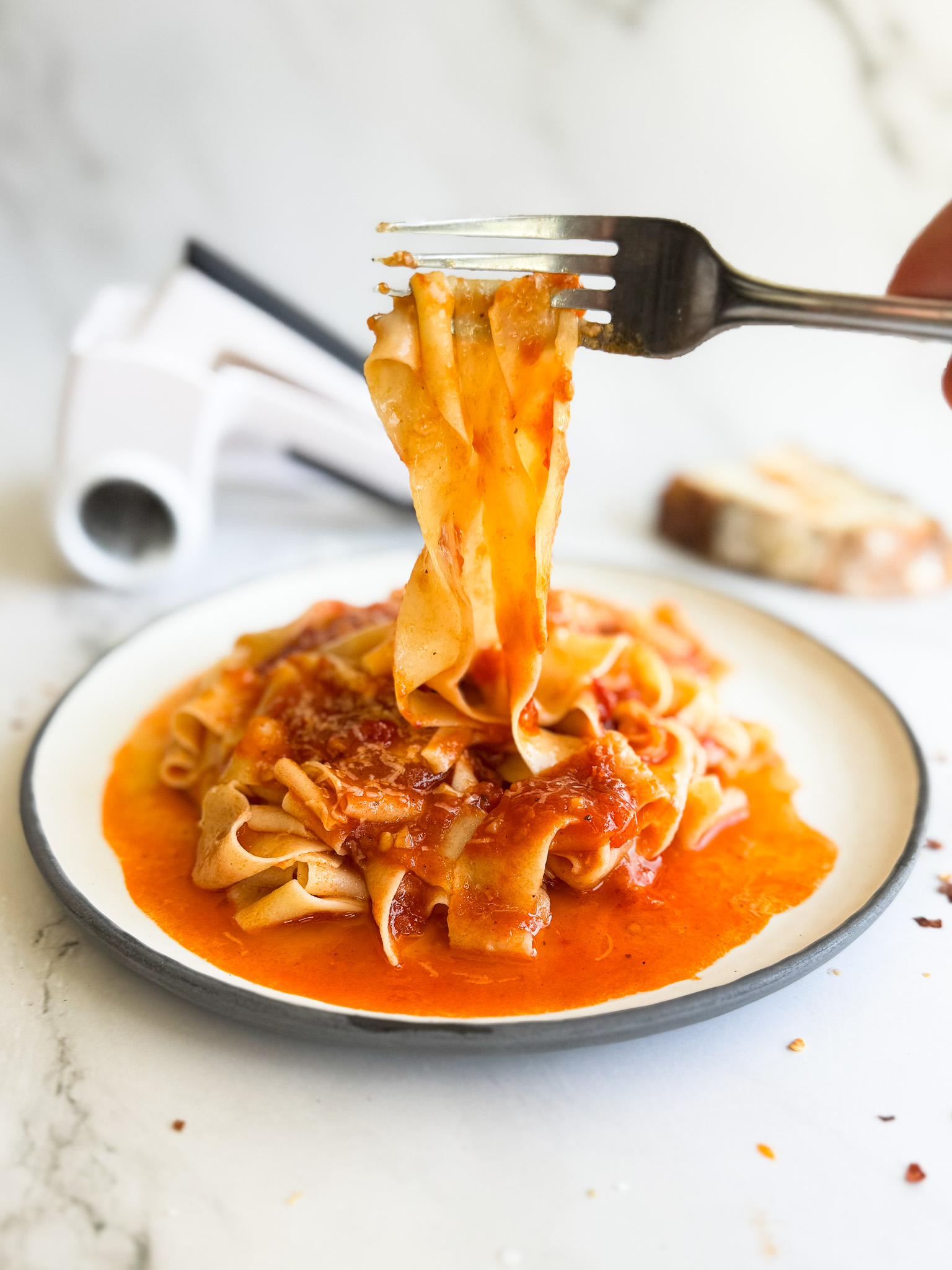Ingredients
- 5 large eggs
- 400 g all purpose flour, (about 2 ½ cups), plus more for dusting
Equipment
Method
Making the Dough: By Hand
- Place a mound of flour on a clean surface and make a large well in the center. Crack the eggs into the well, and use a fork to break up the yolks and begin to whisk.
- Beat with the fork as you incorporate more flour until the egg/flour mixture becomes extremely thick and gooey. When you pick up your fork the mixture should hold onto it and slowly fall (not "rip").
- Using a bench scraper, scrape up the flour and fold over the egg mixture from each side. Continue doing this until almost all of the flour has been incorporated. Begin scraping in a scooping circular motion and folding the dough over itself. Continue doing this until it somewhat comes together into a dough mass.
- Begin to knead the dough together into a cohesive ball by folding it over itself multiple times until it's no longer too sticky to handle. Work the remaining flour in and begin kneading the dough with the heel of your palm, dragging the dough away from you.
- Knead for 5 minutes or so until the dough is smooth and supple, and springs back when poked. Wrap the dough in plastic wrap and place it in the fridge for 2 hours.
Making the Dough: Stand Mixer
- Using a dough hook, mix the eggs on medium speed. Once an egg-y slurry forms turn up the speed to medium-high. It will start pulling more dough in and you will want to turn it back down to medium, even medium-low if it's kicking up a lot of flour. Once it's more cohesive you can turn it back up to medium. This should take about 2-3 minutes.
- It's going to look really scraggly for a while, but it will start to come together after another few minutes on medium - if it's not coming together, add 1-2 tbsp of water to help. Do not add too much, the dough should be quite firm.
- Once the dough comes together into a dough ball, turn the speed down to the lowest setting and let it knead for 3-5 minutes. If your stand-mixer is like mine, it might dislodge - so be careful. I end up removing it and kneading by hand until it's smooth and supple, and springs back when poked (about 3 minutes).
How To: Rolling Out The Dough
- Cut the dough into 6-8 pieces and cover all but one to ensure they don't dry out.
- Press the first piece of dough into a disc and coat it lightly in flour. Using either a hand crank or powered pasta roller machine, adjust the thickness setting to 1 (the largest setting) and run the disc of dough through on low-medium speed.
- Fold the flattened dough in half like a book, running the widest side through the pasta roller first. Ideally, your pasta sheets will run the full width of the pasta roller so you have a somewhat square shape. Continue to fold a handful of times and run through the pasta roller without adding more flour until it is the desired shape.
- Once the dough is the full width of the pasta roller, coat it in flour and adjust the thickness setting on the machine to 2. Run the dough through the machine. Continue to do this, adding more flour if necessary, until you reach the 3rd thinnest setting (for me that's 6). At this stage you may either wish to run it through to 7 or to 8 depending on preference and your machine.
- Tip: Make sure you're running the dough sheets through straight (if they're crooked they may tear) and catch them with your other hand to ensure the dough doesn't stretch unnecessarily. You can do this yourself more easily with a powered pasta roller, but it's a great time to get a hand in the kitchen if not.
- Before running the pasta sheet through the final time or last 2 settings, coat generously in flour - this is where it is at the highest risk to tear. Lay the sheet down on a flat surface and coat well in flour.
How To: Cut Noodles
- With a pasta sheet there are a number of different noodles you can easily make with a knife. If you have a cutting attachment you can run the sheets through to make spaghetti or fettuccini.
- To cut the noodles - make sure you flour both sides of the pasta sheet well before folding. Let them sit uncovered for 5 minutes to dry out slightly. Fold one end of the sheet over 1/4 of itself, then fold that section again over another 1/2 of the dough. One last fold will cover the last bit of unfolded pasta. This enables you to cut longer noodles.
- Use a sharp knife to press down/cut through the sheets in your desired thickness. Do not drag the knife. Immediately after cutting, unroll the pasta and toss in plenty of additional flour and set aside.
How To: Cooking Fresh Pasta
- Cook your pasta once everything is ready and you are about to eat.
- Bring a pot of well-salted water to a boil. Add the fresh pasta and cook, stirring occasionally, for 2-4 minutes until al dente. They will no longer be chewy but have a distinct bite. Try a noodle every 30 seconds after 2 minutes until you find the texture you like!
- Remove the noodles from the boiling water and either add straight into your sauce or serve into individual bowls and top with sauce.
